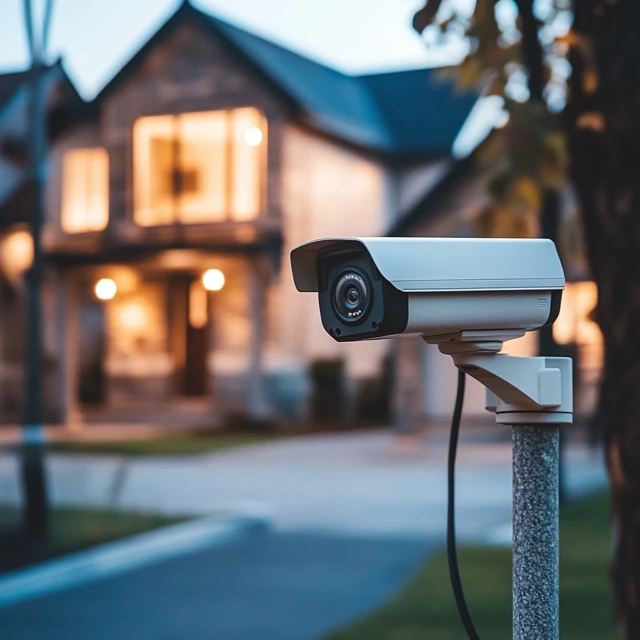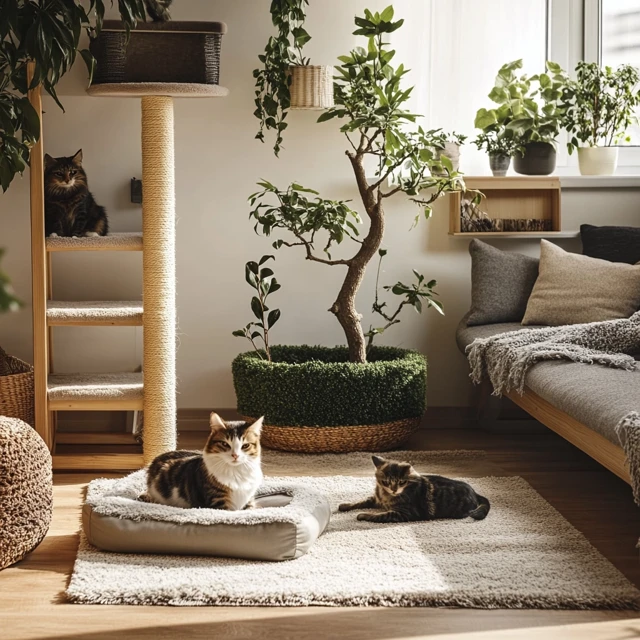Introduction: A Stylish Haven for Pets & People
Owning pets doesn't mean you have to sacrifice a beautifully designed home. By choosing durable,
low-maintenance materials and planning around your furry friend's needs, you can create a living
space that's both elegant and comfortable—for humans and animals alike.
In this guide, we'll explore solutions for floors, furniture, fabrics, and even décor arrangements
that can withstand paws, claws, fur, and the occasional mess. Let's dive into practical ways to
keep everyone happy at home.
1. Flooring That Withstands Paws & Claws
Pets track dirt, drool, and can scratch surfaces easily. Choose floors that resist damage
and clean up effortlessly:
- Tile or Stone: Hard surfaces like porcelain or ceramic tile resist
scratching, plus they're simple to mop up in case of accidents. Consider textured tiles
for better pet traction.
- Vinyl Planks (LVP): Luxury vinyl looks surprisingly like wood or stone
but offers water-resistance and a softer feel underfoot. Claws typically won't dent it.
- Laminate with Scratch-Resistant Coating: Some modern laminates have
tough top layers. Just ensure spills get wiped quickly to prevent swelling at seams.
- Avoid Softwoods & Carpets: Pine or other soft woods easily
dent, while carpets hold onto fur, odors, and stains. If carpet is necessary, pick
stain-resistant or low-pile options.
Pet-friendly floors help keep your home looking neat—no matter how many zoomies or
muddy paws cross it each day.
2. Furniture & Fabrics That Resist Fur & Stains
Your couch or bed sees the brunt of pet snuggles. Pick materials that shrug off fur
and are easy to clean:
- Leather or Faux Leather: Real or synthetic leather can be wiped down
quickly, though sharp claws might cause punctures. Regular conditioning helps maintain
its finish.
- Microfiber or Performance Fabrics: Tightly woven fibers repel fur and
are less prone to snagging. Look for “performance” labels indicating stain and moisture
resistance.
- Washable Slipcovers: If your pet loves the sofa, slipcovers are a game-changer.
Toss them in the washer when they get grimy or hairy.
- Dark or Patterns Over Light Solids: Patterns or darker tones hide fur
and minor stains better than pale solids, reducing the constant “lint-roller” look.
By opting for durable textiles and easy-wipe surfaces, your furniture stays presentable—even
after Fido's nap or your cat's climbing spree.
3. Designated Pet Zones & Organization
Giving your pet a clear spot for eating, sleeping, or playing reduces mess around the rest of the house.
A few suggestions:
- Feeding Station: Place food and water bowls on a rubber mat to catch spills.
Keep it in a low-traffic area so pets can eat calmly, and you can easily wipe up.
- Hidden Litter Box Solutions: Transform a repurposed cabinet or bench into
a discreet litter area. This keeps unsightly trays out of direct view while containing odor and mess.
- Pet Bed Corners: Cozy up a corner with a bed or cushion your pet loves.
If your dog or cat feels they have a secure retreat, they're less likely to claim your brand-new couch all day.
- Toy Baskets & Storage: Store chew toys, squeakers, or cat wands in
a decorative basket. Encouraging your pet (and yourself) to keep them gathered helps
your floors stay clutter-free.
Structuring your home so pets have dedicated spots fosters harmony and tidiness,
letting you maintain style without constant mess.
4. Protective Measures for Walls & Decor
Pets can inadvertently scratch paint or knock over décor. Safeguard your walls and items from typical mishaps:
- Scratch Guards or Clear Films: For areas cats like to scratch,
apply transparent adhesive guards or corner protectors. They're nearly invisible but spare your paint.
- Wall-Mounted Décor vs. Freestanding: Shift easily toppled vases
or frames to wall-mounted shelves or hooks. This prevents wagging tails from
accidental smashes.
- Secure Cords & Wires: Pets chewing cords can be dangerous.
Bundle them in cable covers or tuck them behind furniture. For curious chewers,
consider bitter sprays or more robust cord protectors.
- Door Scratch Protectors: If your dog scratches the door to go out,
attach a clear plastic shield at doorknob-level. This keeps paint or wood intact
beneath excited paws.
Simple preventative steps let your décor flourish while keeping destructive or
harmful pet behaviors at bay.
5. Easy-to-Clean Paint & Surface Choices
Minimize frustration from muddy paw prints or drool spatters by choosing surfaces
that wipe clean:
- Semi-Gloss or Satin Paint: Walls with these finishes resist
stains better and wipe down easily. Flat paint might show marks more readily.
- Mudroom or Foyer Wainscoting: If you have an entryway,
consider a wainscot or beadboard. This lower panel can be quickly cleaned
if dogs shake off water or dirt after a walk.
- High-Gloss Trim: Moldings or baseboards are prime drool
and scuff targets. High-gloss finishes deflect marks and are simpler to
spot-clean.
- Stain-Resistant Countertops: If your cat roams the counters,
quartz or sealed granite handle scratches and smears better than less robust
materials.
These small design decisions accumulate into a more pet-compatible home that
doesn't demand constant re-painting or scrubbing.
6. Pet-Safe Plants & Décor
Many people enjoy greenery indoors, but some plants can be toxic to pets.
Balance style with safety:
- Pet-Safe Plants: Examples include spider plants, Boston ferns,
parlor palms, and African violets. They're non-toxic (still, some nibbling
is normal—monitor if your pet is a big chewer).
- Avoid Toxic Greens: Lilies, sago palms, and certain philodendrons
are hazardous if ingested. Check an ASPCA plant guide before bringing new
foliage home.
- Hanging or Elevated Pots: If your cat loves munching leaves,
suspend planters or place them on tall shelves. Keep wiring or stands stable
to avoid toppling.
- Minimal Small Breakables on Tables: One swish of a dog's tail
can knock items off low surfaces. Prioritize robust ceramics or anchored decorations.
Maintaining a house full of healthy plants and playful pets is entirely possible
when you choose non-toxic species and position them carefully.
Materials & Finishes: Pet-Friendliness at a Glance
| Material |
Pros |
Cons |
Pet-Friendliness |
| Hardwood (Oak, Maple) |
Durable, classic, can be refinished |
May scratch if not well-sealed, water damage risk |
Good if sealed, keep nails trimmed |
| Laminate Flooring |
Scratch-resistant top layer, budget-friendly |
Moisture can warp edges, less “real wood” feel |
Solid for high-traffic pet areas |
| Leather Furniture |
Wipes clean, stylish patina over time |
Sharp claws can puncture, needs conditioning |
Better with calmer pets or trimmed nails |
| Performance Fabrics |
Stain-resistant, easy to spot-clean |
More expensive, fewer pattern choices |
Great for sofas & chairs |
| Tile / Stone Flooring |
Highly scratch-resistant, easy to mop |
Can be cold & slippery |
Ideal for messy or hot climates |
Use this quick reference to decide on floors, fabrics, or furniture finishes
that handle the rigors of daily pet life without losing style.
Conclusion
Designing a pet-friendly home doesn't mean compromising on looks. With
thoughtful floor choices, durable (yet cozy) furniture, designated pet zones,
and protective accents, you can keep your space stylish while accommodating
the daily antics of your furry companions.
Ultimately, it's about finding a balance—fabrics that resist fur, surfaces
that stand up to muddy paws, and strategic décor placement that minimises
breakage or damage. When you plan ahead, you and your pets can both revel
in a comfortable, beautiful living environment for years to come.

